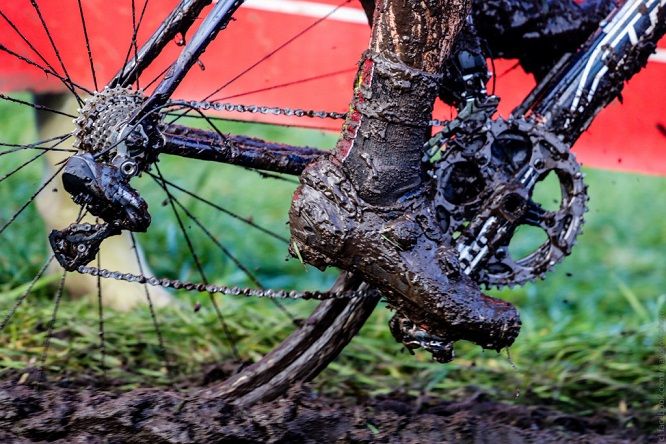Frame and All
Before getting into the nitty-gritty, give your entire bike a postride rinse. “It seems like a no-brainer,” says Jeremy Porter, a mechanic at Rose Bike, where spring is known as mud season. “But you’d be surprised how many people don’t do it.”
Keep the hose on a gentle setting, Porter advises, as high pressure can force grit or soap into the bearings.
Drivetrain Components
Spinning wheels constantly fling muck onto these low-hanging parts. Combine grit with hard-to-reach spots and pivoting areas and you have a recipe for fast wear.
Hose the drivetrain to flush out the dirt. Then, wipe it down with a soapy sponge, paying special attention to derailleur pulleys, the chain, the space between each cog in the cassette, and the backsides of the chainrings. Rinse everything again, then dry. Apply a light coat of wet lube to the chain.
Suspension Links
Because of their location, usually near your rear wheel or between it and the bottom bracket, mountain bike suspension pivots are exceptional mud-catchers. Leave the gunk there and it can work its way into bearings or bushings and cause premature wear.
Slip a rag or brush into crevices to clean out grime.
Fork Wipers
If you have a suspension fork, mud from the front wheel can collect where the upper and lower tubes slide together. Leave it there and it will work past the seals and into the fork’s internals.
Thoroughly wipe down the fork’s upper legs and seals with a rag. Beyond that, follow the manufacturer’s recommended service schedule—replacing worn seals and the fork’s lubricating oil will remove any grit that slips through.
Brake Shoes
Mud on the wheels can become caked in rim-brake pads, where it grinds against the rims and speeds the wear of the braking surface.
Check the pads for embedded grit. Use a sharp tool, like a knife or awl, to pick out any debris you find.
Easy Off
Pedro’s Toothbrush has a soft brush on one end to scrub drivetrain surfaces and firm bristles on the other to get deep between cogs.














